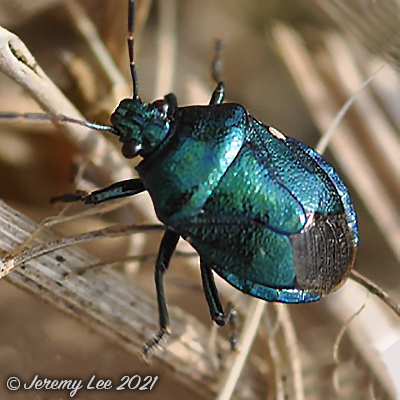
 |
|
Scientific Classifications explained » Amphibians » Ants » Aphids » Bees » Beetles » Birds » Bugs » Butterflies » Caterpillars » Damselflies » Dragonflies » Earwigs » Flies » Frog/Leafhoppers » Fungi » Galls » Grasshoppers » Harvestmen » Hoverflies » Lacewings » Ladybirds » Leaf Mines » Lichens » Mammals » Millipedes » Mosses » Moths » Sawflies » Slugs » Snails » Spiders » Trees » Wasps » Wild Flowers » Woodlice |
UK Nature > Bugs > Zicrona caerulea

Scientific Name: Zicrona caerulea Common Name: Blue Shield Bug One of the UK's smallest shield bugs (usually around 5-7mm in length), Zicrona caerulea has a deep blueish green metallic colouring that can vary according to the lighting conditions and a very dark wing membrane. The larvae are very different though, displaying a bright red colouration with black markings. Adults are usually first seen from April onwards (my specimen was photographed in Lincolnshire on the 17th of April); they have one brood a year and the first of the new generation of adults can be seen from July onwards. Occuring on low vegetation in a variety of habitats, but not often seen in suburban gardens, Zicrona caerulea is a predatory species, very often feeding off the larvae of Altica oleracea (Chrysomelidae). It can be found throughout the United Kingdom, but is absent from Ireland. |
|

https://www.uknature.co.uk is a website dedicated to showing the immense diversity of UK nature and wildlife. Our vast range of habitats, from lowland arable to snow covered mountains, from storm-ravaged coastlines to peaceful inland freshwater lakes and rivers, from dry, sandy heaths to deciduous and coniferous forests, all these habitats contribute to the abundance of UK nature. We have wild birds in huge numbers either residing or visiting our shores (597 recorded species as at July 2013) and we must also not forget the humble back garden with its grass lawns, flower beds filled with nectar rich flowers, shrubs and trees, all designed to attract huge numbers of insects such as bees, moths, butterflies and hoverflies; and finally the small ponds which provide safe havens for frogs, toads, newts and even slow worms and grass snakes. www.uknature.co.uk is the showcase for my personal passion, photographing uknature in all its glory. I sincerely hope you all enjoy the fruits of my labours. This site and all images contained therein is © Jeremy Lee 2004 - 2021. All Rights Reserved. Site design by Jeremy Lee. Site development & IT Support by Stuart Lee. |